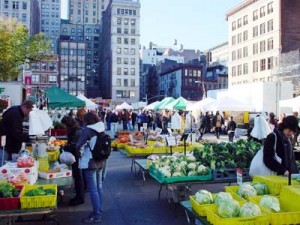
There’s been a bit of press backlash against eating locally lately (see here and here). It’s too bad because such spin and counterspin has the effect of everybody being confused about what to do and therefore doing nothing. Michelle, my wife, calls it “stasis through obfuscation.” Others refer to it as FUD (fear, uncertainty and doubt), a marketing method that weakens a competitor’s position simply by appealing to fear in the consumer.
The FUD technique has the effect of maintaining the status quo and is generally perpetrated by whomever currently dominates the market. A phone call from a front organization for Acme Giant Food Corporation to a friendly journalist may, for example, go like this: “Hey, you know all the hype around local food? Well, here’s a lead on a great contrary story. Did you know that if the local food is produced in an oil-heated greenhouse…” Next thing you know, there’s a story in the paper about how local isn’t always more environmental. Everybody is confused, their attempts to change grind to a halt, and the Acme Giant Food Corporation wins. Stasis through obfuscation.
But that’s not the real point of this post. The real point is to discuss the nuances that I use to modify my “local food only” regime in order to make it low impact. Some studies show that up to a quarter of an individual’s environmental impact comes from his or her food consumption. Food’s footprint comes from its production, its processing, its packaging, and its distribution (I’m writing off the top of my head here, so feel free to weigh in).
I’m going to look at each, but first, in case you need to get to work, here is the summary of food rules that, as far as I can tell, is the most environmental: A diet that is local, unfrozen and unprocessed, seasonal, organic or near-organic, has no packaging and is based on mostly grain and vegetables, including little or no beef or dairy (full disclosure: we’re not entirely off the dairy).
Surprise, surprise! Eating a diet that is healthy for the planet also turns out to be pretty much what nutritionists have wanted us to eat all along.
Now, here’s a little more detail:
Production has its impact by water use, land use, energy use, and herbicide and pesticide use:
- Eat organic or close to it—to cut down on the chemicals. When buying in the supermarket, the organic certification is most important. When buying directly from small farmers (who may not have the time, money or inclination to go through the certification process), a discussion with the farmers about their methods and the knowledge that their neighbors are watching them satisfies me.
- Reduce beef consumption—which has a high impact because of land use, water use and, well, stomach gas (cow burps are made of methane). If you’re a beef eater, you may want to switch to chicken, lamb and pork which have lower impact. Far away lentils are probably better for the environment than local beef. PS My family doesn’t eat meat or fish at all.
- Eating seasonally—avoids carbon emissions produced by oil-guzzling boilers used to heat greenhouses and by power plants used to keep things frozen. Beware! This means a lot of root veggies in winter.
Processing includes cooking or rendering or freezing or any other form of preparation that takes energy:
- If you’re veggie, eat more eggs than cheese—one pound of cheese takes ten pounds of milk to make. It has about the same impact as a pound of beef. I’ve read that far-away beans as a protein source may be better than local cheese.
- Eat fresh and seasonal—freezing and keeping food frozen is not so low impact.
- Can you believe that means ice cream is out?
- Can you believe so is beer and wine and soda too?
Packaging means plastic and cardboard and boxes and bags that all get thrown away. We don’t buy any food that has it.
- Take egg and berry cartons back to the farmer for reuse.
- Bring your own cloth shopping bags and buy loose produce.
Distribution means transportation and the average piece of American food has traveled 1500 Miles to get to your plate. I emphasize local because:
- A regional and local food system would release five to seventeen times less carbon dioxide into the atmosphere than our current national and international model (according to this Leopold Center for Sustainable Agriculture study).
- Direct relationship with the market farmers builds community.
- Locally grown produce doesn’t have to be picked weeks before eating so it is fresher and riper.
- Buying local help keep the greenbelt around the city undeveloped.
- Local farmers support biodiversity since they are not restricted to crop varieties that travel well and package easily.
Image of Union Square Farmers’ Market courtesy of Urban75.Org.